|
Having trouble viewing this email? View it as a Web page.

|
|
|
Fresh from the Field is a weekly album showcasing transformative impacts made by grantees supported by the National Institute of Food and Agriculture.
Sept. 28, 2017
|
|
Success stories
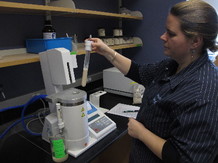 Brewers, bakers, and safe
local grains
As more consumers enjoy
visits to local breweries, distilleries, and bakeries, the need for safely
sourced local grains arises as well. The University of Vermont Extension’s (UVM)
Northwest Crops and Soils Program created the Cereal Grain Quality Testing
Laboratory in 2010 in response to this growing demand. The lab conducts quality
and safety testing services for growers and processors; analyzes grain samples;
and helps growers determine the quality and safety of their products before
they reach the marketplace. UVM has tested more than 2,200 samples from
commercial operations; and 2,000 samples from other universities. Farmers from
23 other states have submitted grain for analysis to the UVM laboratory.
In 2016, more than 700
commercial samples were requested. As a result of the research, participating
farmers have seen an average $7,000 in economic gain, and some Vermont
commercial bakers are able to feature 100 percent local grain breads.
Read more at the UVM’s page. Image provided by UVM
Cereal Lab.
|
News Coverage
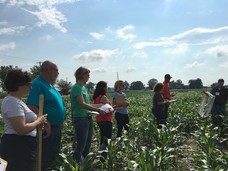 Teachers use summer break
to learn about ag tech
How do you engage students
in agricultural sciences? First, reach the teachers. This summer, Ohio
State University’s Western Agricultural Research Station gathered 14 teachers
for a field tour to introduce them to new concepts, practices, and career
opportunities in agriculture for students.
Teachers learned about
STEM-themed modules and hands-on activities that they could take back to the
classroom. In plots at the research station, they practiced using GreenSeeker,
a handheld device with optical sensors that can prescribe appropriate amounts
of fertilizer to individual plants to provide maximum yield. They also
learned about some of the important research projects at the research station –
more than 230 projects taking place on more than 300 acres. All aspects of
agronomic production are being tested at the station, mostly corn and
soybean.
Read more at Grow Next Gen. Image
provided by Sally
Ewan-Education Projects.
|
The Library
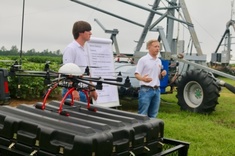 Clemson precision ag
research means savings for South Carolina farmers
Most
sandy soils in South Carolina have a compacted zone, called a hardpan that roots
can’t penetrate. If the hardpan isn’t tilled, plant roots can’t reach the water
and nutrients in the deeper soil. The hardpan costs a great deal of fuel to
till, and it can also reduce crop yields by as much as 50 percent.
Clemson
University researchers are
developing a real-time, variable-rate tillage system that uses sensor
technologies to pinpoint the depth and thickness of the soil hardpan. The
technology communicates with the tillage equipment to automatically adjust the
blade depth. As a result, farmers don’t till soil and don’t till deeper than
needed.
The
research project resulted in fuel savings of up to 45 percent for participating
farmers.
NIFA
supports the research through the Agriculture and Food Research Initiative
(AFRI).
Learn
more at the Newstand. Image
provided by Scott Miller-Clemson University.
|
Video
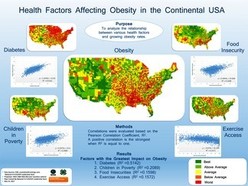 4-H mapping all over the world
The ancient art of
cartography is getting a new twist with tech-savvy 4-H youth, who are learning
to create informative printed and online maps using geographic information
systems (GIS) tools.
During
the Environmental Systems Research Institute, Inc. (Esri) GIS Conference
last July, representatives of the National 4-H GIS/GPS Leadership Team from
Unicoi County, Tennessee, shared 4-H GIS programs to 16,000 GIS professionals
and educators from over 100 countries attending the conference.
The 4-H team, composed of
youth-adult teams from New York, North Carolina, and Tennessee, completed a
mapping project looking at correlations of health conditions that contribute to
obesity, such as diabetes, children in poverty, and food insecurity. They found
the strongest correlation with diabetes, followed by children in poverty.
Watch the Esri video. Image provided by National 4-H GIS
GPS Leadership Team.
|
Tweet of the Week
#NIFAIMPACTS
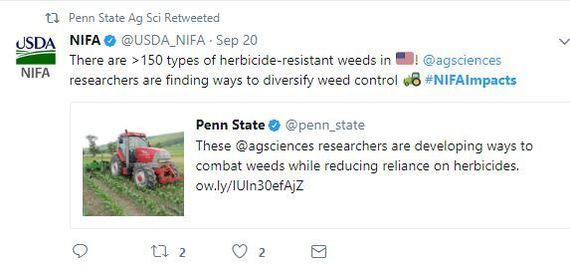
|
|

NIFA’s mission is
to invest in and advance agricultural research, education, and extension that
solve societal challenges. NIFA’s investments in transformative science
directly support the long-term prosperity and global preeminence of U.S.
agriculture. To learn more about NIFA’s impact
on agricultural sciences,
visit www.nifa.usda.gov/Impacts, sign up for email updates or follow us on Twitter @USDA_NIFA, #NIFAImpacts.
###
USDA is an equal opportunity lender, provider, and
employer.
Editor: Falita Liles
|
|